In today's digital age, "the video" has emerged as one of the most powerful tools for communication, marketing, and storytelling. It has revolutionized the way we consume content, interact with brands, and share information globally. Whether you're a content creator, marketer, or simply someone who wants to understand the impact of videos, this article will provide you with everything you need to know about "the video".
From social media platforms to online advertising, videos have become an integral part of our daily lives. They offer a dynamic way to engage audiences, convey complex ideas, and evoke emotions effectively. As video consumption continues to grow, understanding the nuances of video production, distribution, and optimization becomes crucial.
In this article, we will delve into the world of "the video," exploring its history, importance, production techniques, and strategies for maximizing its impact. Whether you're a beginner or an expert, this guide will provide valuable insights and actionable tips to help you leverage the power of videos.
Read also:Aishah Sofey S The Rising Star In The Entertainment Industry
Table of Contents
- The History of Video
- Why Video Matters in the Digital Age
- Types of Videos and Their Uses
- The Video Production Process
- Top Platforms for Video Distribution
- Optimizing Videos for Search Engines
- Video Marketing Strategies
- Emerging Trends in Video Content
- The Future of Video Technology
- Conclusion: Embrace the Power of Video
The History of Video
The evolution of "the video" dates back to the late 19th century when motion pictures were first introduced. The invention of the cinematograph by the Lumière brothers in 1895 marked the beginning of a new era in visual storytelling. Over the years, advancements in technology have transformed videos from simple black-and-white films to high-definition, interactive content that we see today.
Key Milestones in Video Development
- 1927: The first synchronized sound film, "The Jazz Singer," was released.
- 1950s: Television became a popular medium for broadcasting video content.
- 1980s: The introduction of VHS tapes made home video recording accessible to the masses.
- 2000s: The rise of YouTube and other online platforms revolutionized video sharing and consumption.
According to a report by Statista, global internet video traffic accounted for 82% of all consumer internet traffic in 2022. This statistic highlights the immense growth and significance of videos in modern communication.
Why Video Matters in the Digital Age
In the digital age, "the video" plays a vital role in engaging audiences and delivering information effectively. It offers several advantages over traditional text-based content:
- Higher Engagement: Videos capture attention faster and keep viewers engaged longer than text.
- Improved Comprehension: Visual aids help audiences understand complex concepts more easily.
- Emotional Connection: Videos evoke emotions and create a stronger connection with the audience.
- SEO Benefits: Videos can enhance search engine rankings and drive more traffic to websites.
A study by Wyzowl revealed that 86% of businesses use video as a marketing tool, and 92% of marketers believe that video is an important part of their strategy. These statistics underscore the importance of incorporating video content into digital marketing efforts.
Types of Videos and Their Uses
There are various types of videos, each serving a specific purpose and catering to different audiences:
1. Explainer Videos
Explainer videos are short, engaging clips designed to educate viewers about a product, service, or concept. They are often used in marketing campaigns to simplify complex ideas and increase conversion rates.
Read also:Anjali Arora Unveiling The Journey Of A Rising Star
2. Tutorial Videos
Tutorial videos provide step-by-step instructions on how to perform a task or use a product. They are popular among DIY enthusiasts and professionals looking to share their expertise.
3. Marketing Videos
Marketing videos aim to promote products or services and drive sales. They can include advertisements, product demos, and brand stories.
Research shows that videos with a clear call-to-action increase conversion rates by up to 20%. This makes them an essential component of any successful marketing strategy.
The Video Production Process
Creating a high-quality video involves several stages, from planning to post-production. Here's a breakdown of the video production process:
Pre-Production
- Define the objective and target audience.
- Develop a script and storyboard.
- Plan the shooting location and schedule.
Production
- Set up equipment and lighting.
- Record audio and video footage.
- Capture b-roll and supplementary shots.
Post-Production
- Edit the footage using video editing software.
- Add music, sound effects, and voiceovers.
- Export the final video in the desired format.
Investing in quality production equipment and skilled professionals can significantly enhance the quality of your videos. Tools like Adobe Premiere Pro and Final Cut Pro are widely used for video editing and post-production.
Top Platforms for Video Distribution
Choosing the right platform for video distribution is crucial for reaching your target audience. Here are some of the top platforms for sharing videos:
1. YouTube
YouTube is the largest video-sharing platform globally, with over 2 billion active users. It offers a wide range of monetization opportunities and analytics tools for creators.
2. TikTok
TikTok has gained immense popularity among younger audiences, with its short-form video format and creative filters. It's an excellent platform for viral content and brand collaborations.
3. Instagram Reels
Instagram Reels allow users to create short, engaging videos that appear in their followers' feeds. They are ideal for showcasing products, services, and behind-the-scenes content.
According to a report by HubSpot, videos posted on social media platforms receive 48% more views than other types of content. This highlights the importance of leveraging these platforms for video distribution.
Optimizing Videos for Search Engines
To ensure your videos rank well in search engine results, it's essential to optimize them using SEO best practices:
1. Use Descriptive Titles and Descriptions
Incorporate relevant keywords into your video titles and descriptions to improve visibility. For example, instead of naming a video "Product Demo," use a descriptive title like "How to Use Our Product: Step-by-Step Guide."
2. Add Captions and Transcripts
Captions and transcripts make your videos accessible to a wider audience and provide search engines with additional text to index. This can improve your video's discoverability.
3. Utilize Tags and Categories
Use relevant tags and categories to help search engines understand the context of your video. For instance, if your video is about cooking, use tags like "recipe," "cooking tips," and "food."
Studies show that videos optimized for SEO receive 1,200% more views than non-optimized videos. This demonstrates the importance of implementing SEO strategies for video content.
Video Marketing Strategies
Effective video marketing requires a strategic approach to reach and engage your target audience. Here are some proven strategies:
1. Create Compelling Content
Focus on producing high-quality, engaging videos that resonate with your audience. Use storytelling techniques to capture attention and evoke emotions.
2. Leverage Social Proof
Incorporate customer testimonials and reviews in your videos to build trust and credibility. Social proof can significantly influence purchasing decisions.
3. Measure and Analyze Performance
Use analytics tools to track the performance of your videos and gather insights. This data can help you refine your strategies and improve future campaigns.
According to a report by HubSpot, businesses that use video marketing grow revenue 49% faster than those that don't. This statistic highlights the potential impact of video marketing on business growth.
Emerging Trends in Video Content
The video industry is constantly evolving, with new trends emerging every year. Here are some of the latest trends in video content:
1. Live Streaming
Live streaming has become increasingly popular, offering real-time interaction and engagement with audiences. Platforms like Facebook Live and Instagram Live have made it easier for creators to connect with their followers.
2. Augmented Reality (AR)
AR technology allows users to overlay digital content onto the real world, creating immersive experiences. It's being used in various industries, from gaming to retail, to enhance customer experiences.
3. Interactive Videos
Interactive videos enable viewers to participate in the content, making decisions that affect the outcome. This format increases engagement and provides a unique experience for users.
These trends indicate the growing demand for innovative and interactive video content. Staying updated with the latest trends can help you stay ahead of the competition.
The Future of Video Technology
The future of "the video" looks promising, with advancements in technology shaping the way we create and consume content. Here are some potential developments to watch out for:
1. Artificial Intelligence (AI)
AI-powered tools can automate video editing, generate scripts, and analyze audience preferences, streamlining the production process.
2. Virtual Reality (VR)
VR technology offers fully immersive experiences, allowing users to explore virtual environments and interact with content in new ways.
3. 5G Networks
The rollout of 5G networks will enable faster video streaming and reduce latency, enhancing the overall viewing experience.
As technology continues to evolve, the possibilities for video content are endless. Embracing these advancements can help creators and businesses unlock new opportunities for growth and innovation.
Conclusion: Embrace the Power of Video
In conclusion, "the video" has become an indispensable tool in the digital age, offering numerous benefits for communication, marketing, and storytelling. By understanding its history, importance, and production techniques, you can harness its power to engage audiences and achieve your goals.
We encourage you to take action by incorporating video content into your strategies and experimenting with new trends and technologies. Leave a comment below to share your thoughts or ask questions. Don't forget to explore our other articles for more insights and inspiration.


